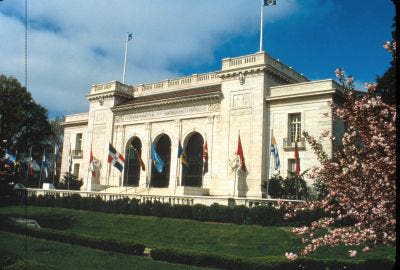
Clem Labine
Why Doesn’t the AIA Have a TAG?
When the American Institute of Architects named self-proclaimed “bad boy” Thom Mayne as recipient of its 2013 Gold Medal, it just underscored the AIA’s one-sided view of the architectural profession. The Gold Medal is the highest honor the AIA can confer on an architect, and a review of Gold Medal Winners over the last 30 years confirms the AIA’s single-minded advocacy of anti-traditional Modernist design.
Though it purports to serve the entire profession, the AIA’s promotion of architecture that disdains ornament and traditional references totally dishonors those architects who choose to work in historically influenced modes. Strangely, an institution you’d expect to be even more rigidly Modernist – the Royal Institute of British Architects (RIBA) – has a somewhat more indulgent attitude towards traditional design. The RIBA has long championed the work of starchitects like Norman Foster and Richard Rogers, defending Modernist buildings against the criticisms of Prince Charles and others.
Nevertheless, the RIBA sanctions the Traditional Architecture Group (TAG) as a linked society of the RIBA. Architectural members of TAG are “committed to developing the values established by long tradition and adapting them to the modern world. Traditionalism looks to the past only to see the future more clearly. Traditionalism is the solid, viable, long-term future for architecture.” One can’t imagine the current AIA ever associating itself with such sentiments. The RIBA, even though Modernist at its core, is at least is willing to admit there is an alternative point of view.
The Traditional Architecture Group
Among the 400 members of TAG are some of England’s leading architects working in traditional styles, including Robert Adam, Graham Rix, Quinlan & Francis Terry,and Alireza Sagharchi (TAG Chairman) of Stanhope Gate Architecture & Urban Design Ltd. TAG members adapt and build upon historical precedents to create contemporary architecture with character, intimate feel, and in aesthetic harmony with its context.
The AIA has nothing comparable to the Traditional Architecture Group. The only area where AIA tolerates traditional design is within the isolated confines of preservation. The AIA’s Historic Resources Committee, comprised of some of the country’s leading preservation architects, is one of the oldest members of AIA’s “Knowledge Communities.” But when it comes to additions to historic structures, or infill in older neighborhoods, establishment architects insist that new work should be Modernist and in high contrast with the old – often fatuously described as “creating a dialogue between old and new.” The main argument for anti-historical Modernism is that new architecture should be “of our time.” The ludicrous assertion that only Modernism is “of our time” has been thoroughly debunked by (among others) University of Colorado’s Dean Mark Gelernter and by architect Steven W. Semes in his ground-breaking book, The Future of the Past.
Unfortunately, current debates about architecture are ideological, not evidence-based. The unhappy reality is that Modernist theory has assumed the status of religious orthodoxy within the architectural establishment. So many architects and institutions have bought into the ideology of Modernism that they can’t afford to question its underlying assumptions. And thus today we find the public realm littered with bizarre, alienating buildings and sculpture – despite the general public’s bewildered and/or hostile reaction to most of these abstract intellectual exercises. Most people prefer order, comprehensibility, and beauty in their buildings and surroundings.
Obviously, those in the AIA hierarchy aren’t going to become card-carrying classicists overnight. But is it too much to hope that the AIA will adopt a more inclusive view of what constitutes “architecture,” and add the equivalent of a Traditional Architecture Group to its Knowledge Communities? Dare we hope for AIA’s return to a more comprehensive definition of excellence – such as it had in 1938 when it awarded the Gold Medal to Beaux-Arts trained Paul Philippe Cret?
Clem Labine is the founder of Old-House Journal, Clem Labine’s Traditional Building, and Clem Labine’s Period Homes. His interest in preservation stemmed from his purchase and restoration of an 1883 brownstone in the Park Slope section of Brooklyn, NY.
Labine has received numerous awards, including awards from The Preservation League of New York State, the Arthur Ross Award from Classical America and The Harley J. McKee Award from the Association for Preservation Technology (APT). He has also received awards from such organizations as The National Trust for Historic Preservation, The Victorian Society, New York State Historic Preservation Office, The Brooklyn Brownstone Conference, The Municipal Art Society, and the Historic House Association. He was a founding board member of the Institute of Classical Architecture and served in an active capacity on the board until 2005, when he moved to board emeritus status. A chemical engineer from Yale, Labine held a variety of editorial and marketing positions at McGraw-Hill before leaving in 1972 to pursue his interest in preservation.









